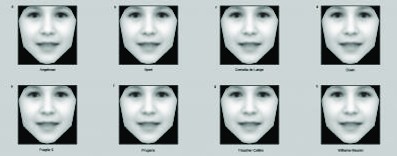The researchers have developed a computer programme that recognises facial features in photographs; looks for similarities with facial structures for various conditions, such as Down’s syndrome, Angelman syndrome, or Progeria; and returns possible matches ranked by likelihood.
Using computer vision and machine learning, the algorithm learns what facial features to pay attention to and what to ignore from a growing bank of photographs of people diagnosed with different syndromes.
The researchers report their findings in the journal eLife. The study was funded by the Medical Research Council (MRC), the Wellcome Trust, the National Institute for Health Research, Oxford Biomedical Research Centre, and the European Research Council.

‘A diagnosis of a rare genetic disorder can…provide parents with some certainty and help with genetic counselling on risks for other children or how likely a condition is to be passed on,’ said lead researcher Dr Christoffer Nellåker of the MRC Functional Genomics Unit at Oxford University. ‘A diagnosis can also improve estimates of how the disease might progress, or show which symptoms are caused by the genetic disorder and which are caused by other clinical issues that can be treated.’
The team of researchers at Oxford University included first author Quentin Ferry, a DPhil research student, and Prof Andrew Zisserman of the Department of Engineering Science.
Identifying a suspected developmental disorder often requires clinical geneticists to come to a conclusion based on facial features, follow up tests and their own expertise.
Between 30 and 40 per cent of rare genetic disorders involve some form of change in the face and skull, possibly because so many genes are involved in development of the face and cranium as a baby grows in the womb.
The researchers set out to teach a computer to carry out some of the same assessments objectively.
They developed a programme that recognises faces in ordinary, everyday photographs, with the programme accounting for variations in lighting, image quality, background, pose, facial expression and identity. It is said to build a description of the face structure by identifying corners of eyes, nose, mouth and other features, and compares this against what it has learnt from other photographs fed into the system.
The algorithm the researchers have developed sees patients sharing the same condition automatically cluster together. The computer algorithm does better at suggesting a diagnosis for a photo where it has previously seen lots of other photos of people with that syndrome, as it learns more with more data.
Patients also cluster where no documented diagnosis exists, potentially helping in identifying ultra-rare genetic disorders.
‘A doctor should in future, anywhere in the world, be able to take a smartphone picture of a patient and run the computer analysis to quickly find out which genetic disorder the person might have,’ Dr Nellåker said in a statement.




Swiss geoengineering start-up targets methane removal
No mention whatsoever about the effect of increased methane levels/iron chloride in the ocean on the pH and chemical properties of the ocean - are we...